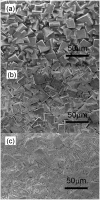Self-separated hydrothermal lead zirconate titanate thick films for high frequency transducer applications
- PMID: 19529788
- PMCID: PMC2682757
- DOI: 10.1063/1.3095504
Self-separated hydrothermal lead zirconate titanate thick films for high frequency transducer applications
Abstract
Using a simple rapid heating process, Pb(Zr(0.52)Ti(0.48))O(3) (PZT) thick films prepared by hydrothermal method were separated from a Ti substrate. Scanning electron microscopy (SEM) revealed that the self-separated films were crack-free. After solution infiltration and high temperature annealing, the PZT thick films were shown to possess good electric properties. At 1 kHz, the dielectric constant and the loss were 593 and 0.05, respectively. The remnant polarization was 30.0 muCcm(2) at room temperature. A high frequency single element ultrasound transducer fabricated with these films showed a bandwidth at -6 dB of 73% at a center frequency of 67 MHz.
Figures





References
-
- Cross L. E. and Trolier-McKinstry S., MRS Bull. MRSBEA 21, 429 (1997).
-
- Polla D. L. and Francis L. F., MRS Bull. MRSBEA 21, 59 (1996).
-
- Zhu B. P., Wu D. W., Zhou Q. F., Shi J., and Shung K. K., Appl. Phys. Lett. APPLAB10.1063/1.2956408 93, 012905 (2008). - DOI
-
- Zhou Q. F., Shung K. K., and Huang Y., J. Mater. Sci. JMTSAS10.1007/s10853-006-1414-8 42, 4480 (2007). - DOI
Grants and funding
LinkOut - more resources
Full Text Sources
Other Literature Sources
Miscellaneous
